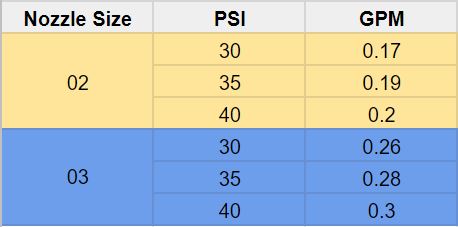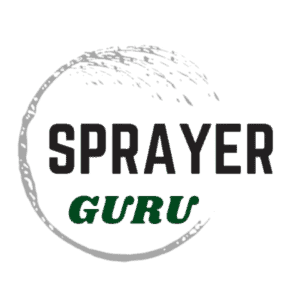A hand pump garden sprayer (often called a tank sprayer) is a useful tool for spraying pesticides, herbicides, cleaners, or sealers. I recently purchased a new one and I was curious as to how far it could actually spray. So I decided to do some testing and find out.
During my testing, I found that a manual or “pump up” sprayer can reach spray distances of 18-20 feet with the nozzle set to spray in a solid stream. When the nozzle is set to a cone it will reach 4-6 feet.
The sprayer’s reach or “throw” depends on many factors including the pressure that the sprayer can produce and the size of the sprayer nozzle being used. Several other factors affect spray distance including things like wind, hose length, and whether the spray is directed horizontally or vertically.
How Far Does a Pump Sprayer Spray?
Knowing the effective reach of a hand pump sprayer is vital to determining if it is the right tool for different jobs. Whether you are spraying trees to cleaning eves on buildings, a sprayer with some good reach is needed.
I decided to do some research and some testing to find out just how far you can expect to effectively spray with a common hand pump sprayer. The key word is “effectively”. It doesn’t do much good if you get a few drops or a fine mist directed at your target, you need a usable spray pattern.
When I reached out to the manufacturers, I found that most of them expected the effective range to be up to 15 ft at maximum pressure. This provided a baseline but I wanted to be certain. So I did a test. As I mentioned earlier, I was able to get about 18 ft of effective spray out of my hand pump sprayer. There are many variables and things to consider before taking this number and running with it so let’s break it down!
Measuring Hand Pump Sprayer Distance
To measure the distance, I used the very “scientific” method of laying a 25-foot tape measure out on the ground when the wind was very minimal. After priming the pump by pumping the handle 7 times (I stopped at 7 because any more and the plunger handle would not go completely back into the pump assembly, and the manual states: do not over-pressurize the pump!). Then, I simply stood and held the wand as I would when using the sprayer and pulled the trigger.
I used only water and let the sprayer spray for a long time. I was able to then observe where the droplets appeared most frequently on the tape measure. This indicated how far the sprayer could reach and still provide effective coverage.

What Factors Affect How Far a Sprayer Can Spray
Spray distance or “reach” is produced by the combination of the pressure and flow rate that the sprayer creates. But, several other factors play a role in determining your spray distance.
Flow Rate and Spray Nozzle Size
Flow rate is measured in gallons per minute (GPM). With a pump sprayer, the flow rate is determined by the spray nozzle being used and the amount of pressure in the tank. Each spray nozzle will allow a certain GPM at different psi. One nozzle may allow 0.2 GPM at 40 psi, while the next size up allows 0.3 GPM at 40 psi. As you can see in the image, the flow rate (GPM) changes as PSI changes.

A higher flow rate will contribute to further spray distance. However, it is not the only factor. Just because a sprayer has a higher flow rate than another doesn’t necessarily mean it will spray further. Pressure is needed to push the liquid through the hose and out the nozzle.
Spray nozzles are super important when it comes to getting effective results. If you want to learn more, then check out these articles for a lot more details about spray nozzles:
Pressure
The amount of pressure that a pump can produce is the other main factor affecting spray distance. Pumping the handle or lever of your sprayer builds the pressure inside the sprayer tank. This pressure pushes the liquid out of the sprayer gun when the trigger is pulled.
Most hand pump sprayers are limited to about 40 psi. The pump assembly and seals have a limit to the amount of pressure they will contain. If you continue to pump your sprayer beyond the maximum pressure, air will escape the sprayer through weak points in the seal, hose connections, tank lid, etc.
Hose Size and Length
Friction loss will reduce your sprayer’s reach. Total friction loss is the compilation of all the components on the discharge side of the pump. In the case of a hand pump sprayer, it would be the suction hose in the tank, the discharge hose, the spray gun, the wand, and the nozzle. Hose size and length are the main causes of friction loss that can be adjusted on a hand pump sprayer.
Every foot of the hose that your sprayer needs to push liquid through takes away from your spray distance. Especially for hoses that have a small inside diameter. A 3/8 inch inside diameter hose will have far less restriction than a 1/4 inch inside diameter hose. Therefore, to increase the spray distance of your pump sprayer, you can either reduce the length of your hose or increase the size of your hose. Or both.
Wind/Elements
Wind, humidity, and temperature can affect spray distance. The wind is a big factor, especially when spraying vertically.
Spray Angle/Pattern
Maximum spray distance is also affected by how you hold or aim your spray gun. Gravity and wind have a major impact on effective spray distance. You may be able to spray 30 feet horizontally, but will not be able to get the same reach vertically.
Many commercial lawn and garden sprayers come with an adjustable spray tip. They can be adjusted to spray in a cone pattern for coverage or a solid stream pattern for distance. Solid stream nozzles will give you more distance compared to a flat fan or cone-style nozzle.
How Can I Increase My Pump-Up Sprayer’s Reach?
Knowing how these small pump sprayers work and what affects sprayer reach, you can make some simple adjustments to increase the range of your hand sprayer.
Use a Different Sprayer Nozzle
When your sprayer is operating at its max PSI, and your nozzle is adjusted to spray in a solid stream, this will be the greatest distance you can achieve without changing the nozzle size. If you bump up to a larger nozzle you may be able to get more distance, but with hand pump sprayers there will be a limit to the nozzle size that will be effective.
In some cases moving to a smaller size nozzle may improve your distance. This would be the case if you are using a “showerhead” style sprayer nozzle or large open tip that is used for watering plants. This would not be common with hand pump sprayers. Most companies that sell these will supply a tip designed for pesticide and herbicide use. But, if this is what is currently on your sprayer, you can change out the wand and tip to something that will provide the restriction needed to generate pressure.
In my test, I used the “standard” spray nozzle that comes with the sprayer. I also tested the sprayer with a larger nozzle size (more GPM). The larger nozzle did not reach as far, only about 15-16 ft. The larger nozzle can potentially spray further than the smaller nozzle size, however, a larger flow rate requires more pressure than the hand pump sprayer can produce.

It is important to keep in mind that with manual pump sprayers, as soon as you pull the trigger the pressure begins to decrease. This means your spray distance will gradually decrease as pressure drops.
Change Your Sprayer Hose
As mentioned earlier. The sprayer hose will affect the distance you can reach. You can potentially get a few more feet out of your sprayer by using a shorter length of hose, but the biggest improvement will come from using a hose with a larger inside diameter.
It may seem like a small change, but moving from a 1/4 inch inside diameter hose to a 3/8 inside diameter hose is a big difference. A 3/8-inch hose more than doubles the area of your hose and therefore greatly increases flow. This will allow for a sprayer with a max of 40 psi to spray further than the same sprayer with a 1/4-inch hose.
To take advantage of the added flow you will want to use a larger spray tip.
Maintain Your Pump Sprayer
Keeping your sprayer in good working condition will help maintain the effective spread distance you can achieve. Chemical residue buildup in your hose and spray gun can contribute to pressure loss. Residue in the pump section can cause the seals or check valve to leak air reducing the maximum pressure of your sprayer. For more details take a look at this guide to cleaning a sprayer and spray nozzles.
Sometimes the spray wand itself will wear out. The tube can crack, residue can build up, and nozzles can wear out. Getting a new spray wand can eliminate those issues that may cause your sprayer to lose distance. The Solo Universal Wand Assembly can be used with many different types of hand sprayers and it comes with the adjustable nozzle I used above to reach 18-20 feet.
- Solo Universal Wand Assembly - 28 in.

- Price: $28.93
Conclusion
Hand pump sprayers are very useful. With this knowledge you can get the most out of your sprayer and with the right adjustments and accessories, you can increase your sprayer's reach. However, it is important to remember there is a limit to the spray distance you can achieve.
